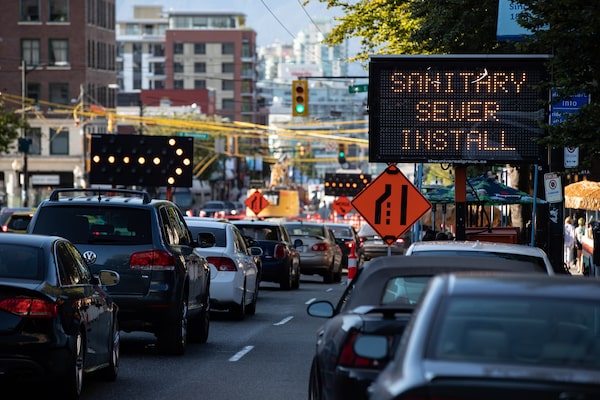
As Canada’s population booms, urban planning experts weigh in on how to alleviate the congestion that comes with the looming population boom.DARRYL DYCK
Canadian cities are lagging when it comes to traffic improvements, says Martino Tran, an associate professor at UBC’s School of Community and Regional Planning.
“The situation is already bad in the context of congestion,” Mr. Tran explains. “To be frank, if nothing happens, the situation will continue to get worse. (It) is already untenable for many people.”
That’s before Canada is faced with a projected population increase to upwards of 52 million people by 2043. Worsening traffic conditions means a current hour-long commute from a suburb to a city centre could extend to 90 minutes. Transit could become more crowded, increasing wait times.
The implications are more than just lost minutes (or cumulative hours) of sitting in traffic.
“Estimates are in the billions of dollars in terms of lost productivity, and there are all kinds of local environmental challenges associated with congestion,” Mr. Tran explains. Quality of life also decreases as congestion increases. Mr. Tran points to the pandemic-era movement of residents leaving cities for less-populated areas, many wanting to escape gridlock.
Mr. Tran says the traditional solution for alleviating traffic congestion has been to increase capacity by building more roadways - but he doesn’t believe it’s a good strategy any longer. “It taps into latent demand, so you actually are worsening the situation,” he explains. “If you increase capacity, you increase the amount of demand that occurs.”
Mr. Tran suggests rethinking when commuting occurs. “How can we decrease demand in aggregate, or shift demand throughout the day to move it off those peak hours?” he asks.
He proposes an employment culture change to rethink what daily work schedules look like and whether they can be outside the typical nine-to-five. Logistics, deliveries and city services could be shifted to off-peak hours, en masse.
“Any creative and innovative ways to do that need to be part and parcel of the entire set of solutions moving forward.”
Strategies such as “congestion charging” — a fee for drivers entering an urban centre — are already found in cities that include Singapore, London, Stockholm and Milan. While it is an effective strategy to reduce congestion, Mr. Tran cautions against this approach. “More affluent households will just be able to buy their way out of it,” he says. “There’s a big equity issue here. Some of the households most dependent on personal vehicles are lower income. We need to be careful about penalizing those households inadvertently.”
Instead of the “stick” approach — discouraging drivers with “penalties” such as fees and taxes — Mr. Tran prefers the “carrot.” By making congestion-alleviating modes of travel, such as public transit, more appealing, drivers will naturally gravitate toward them.
“In most western countries in Europe (taking public transit) is not only efficient and more affordable, but it’s a pleasurable experience,” he says. Improving public transit in Canadian cities could mean adding buses and trains to reduce wait times, reducing fares, and updating vehicles.
Canada’s population boom will be fuelled by immigration. According to Statistics Canada, about four-fifths of the country’s 1.8 million population increase from 2016 to 2021 was attributable to permanent or temporary immigrants to Canada. That trend is expected to continue post-pandemic.
Urban and suburban areas that are expecting more newcomer residents should be prioritized when it comes to transit planning, says Eric Miller, director of the University of Toronto Transportation Research Institute.
“Often the only place they can find housing is in areas that don’t have good transit,” he explains. “Affordable housing is as much a transportation issue as it is a housing issue.”
Mr. Miller encourages city planners to question where new housing is being built and what transportation systems are in place to accommodate new residents — something he says is not happening enough.
“Can we be building affordable housing that has good accessibility to jobs and to stores?” he asks. “Those two conversations are, to a large extent, disconnected. People are talking about housing, or they’re talking about congestion and the pollution from cars, but we’re not putting those two things together very well.”
There is no “silver bullet” solution, Mr. Miller says. Large-scale, impactful solutions, such as constructing more rail systems, can take decades to implement.
“But in the meantime, there’s much more on the transit side that we can do,” Mr. Miller says. “There’s a lot that technology can do to provide buses and streetcars with transit signal priority. We can be creating express lanes or rapid transit facilities.”
More importantly, these solutions take much less time to put into place. For drivers, there are also quicker strategies to reduce gridlock.
“There’s a lot of artificial intelligence and data-driven sensors, using data for real-time control,” Mr. Miller says. “We could be doing be much more with smart traffic signals that are coordinated with one another and are dynamically adjusting to try to keep the traffic moving as best as possible. On highways, we could be doing ramp metering to control the flow on access ramps in rush hour so that you don’t disrupt the flow.”
Cities like Seoul and Phoenix are already using smart traffic signals.
Resolving traffic congestion is a daunting task, but Mr. Tran says he doesn’t believe it’s too late to change course and improve gridlock by implementing the right set of strategies ahead of Canada’s impending population boom.
“We can get our way out of this,” he says. “That is my most optimistic self.”